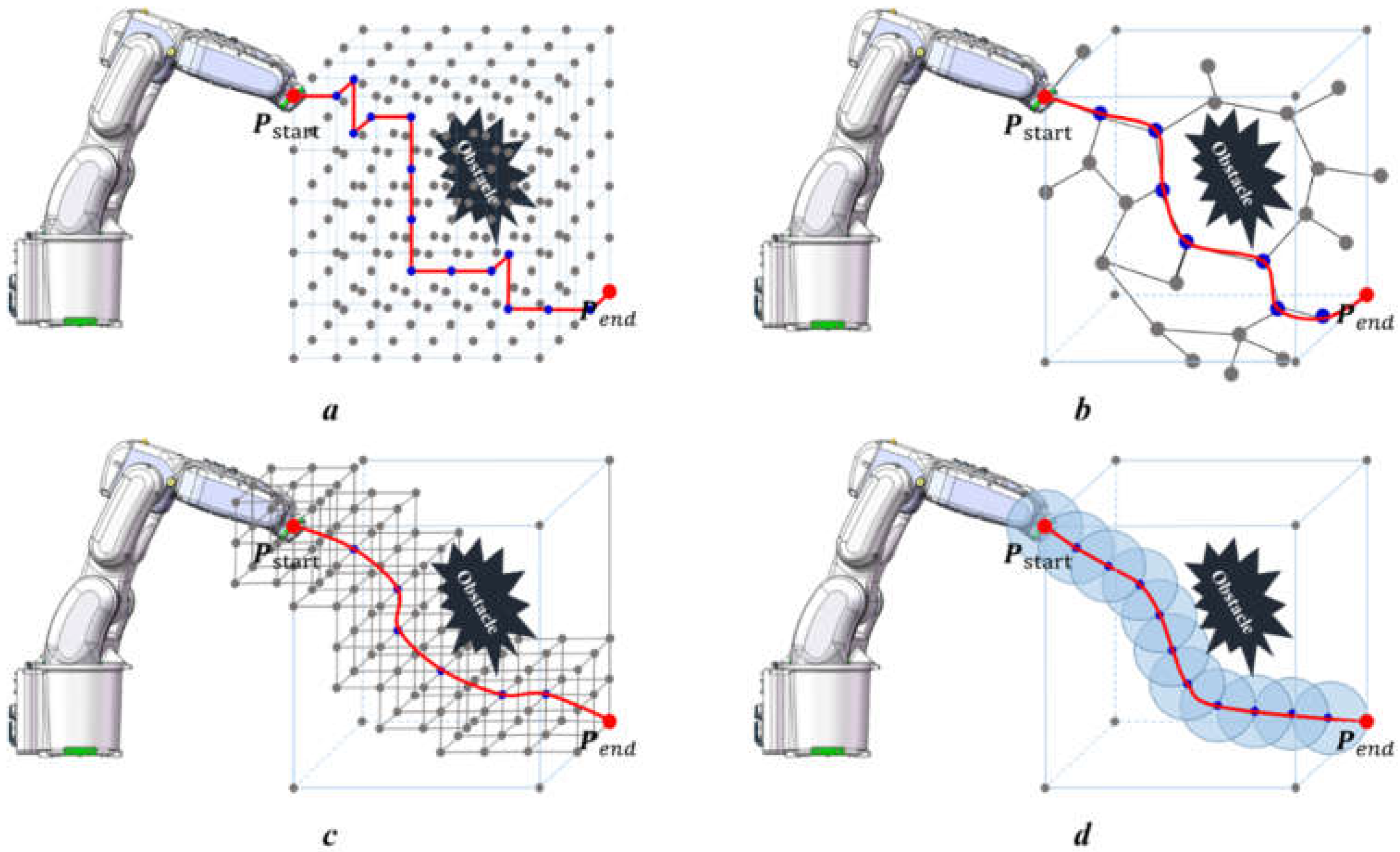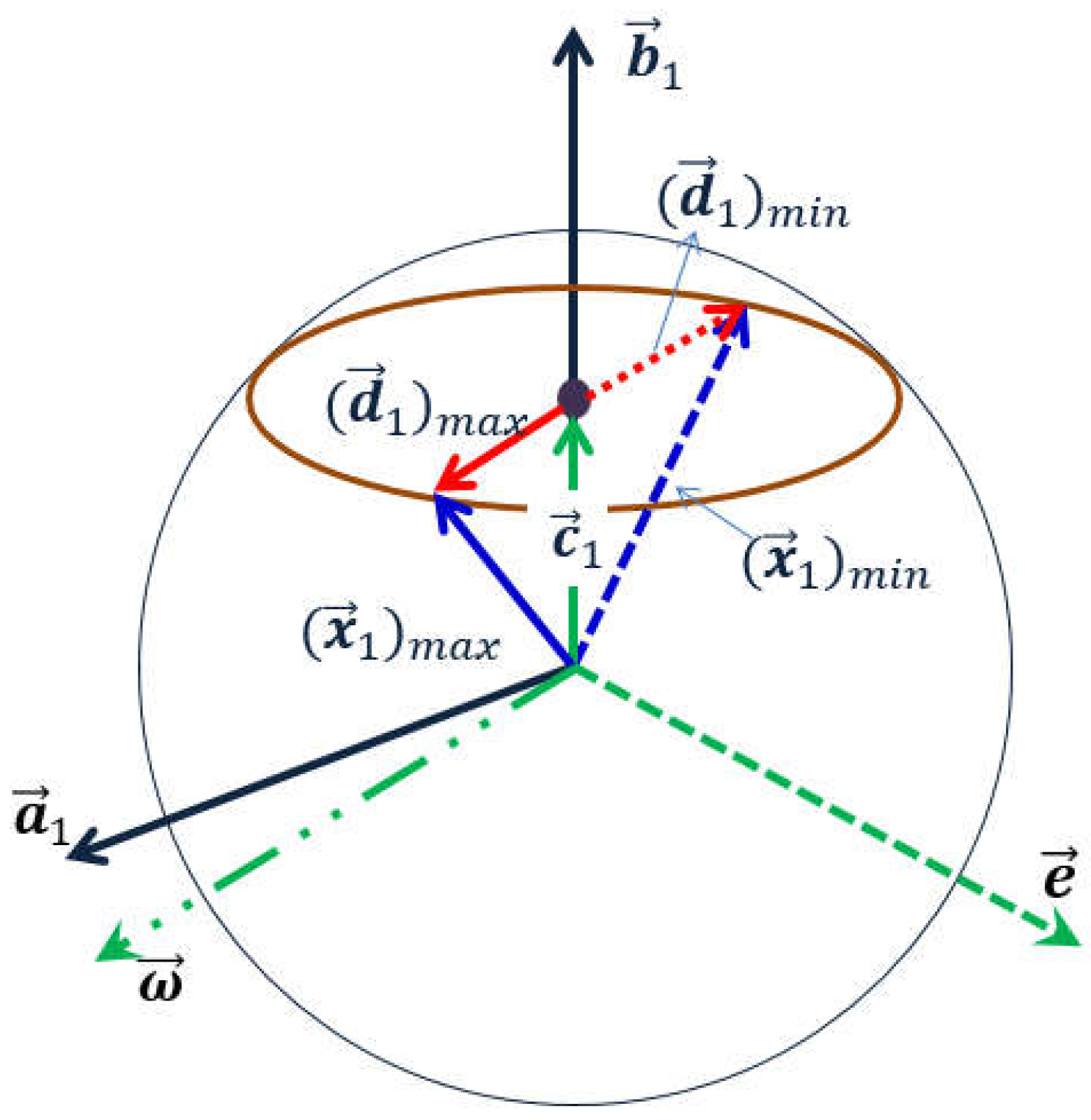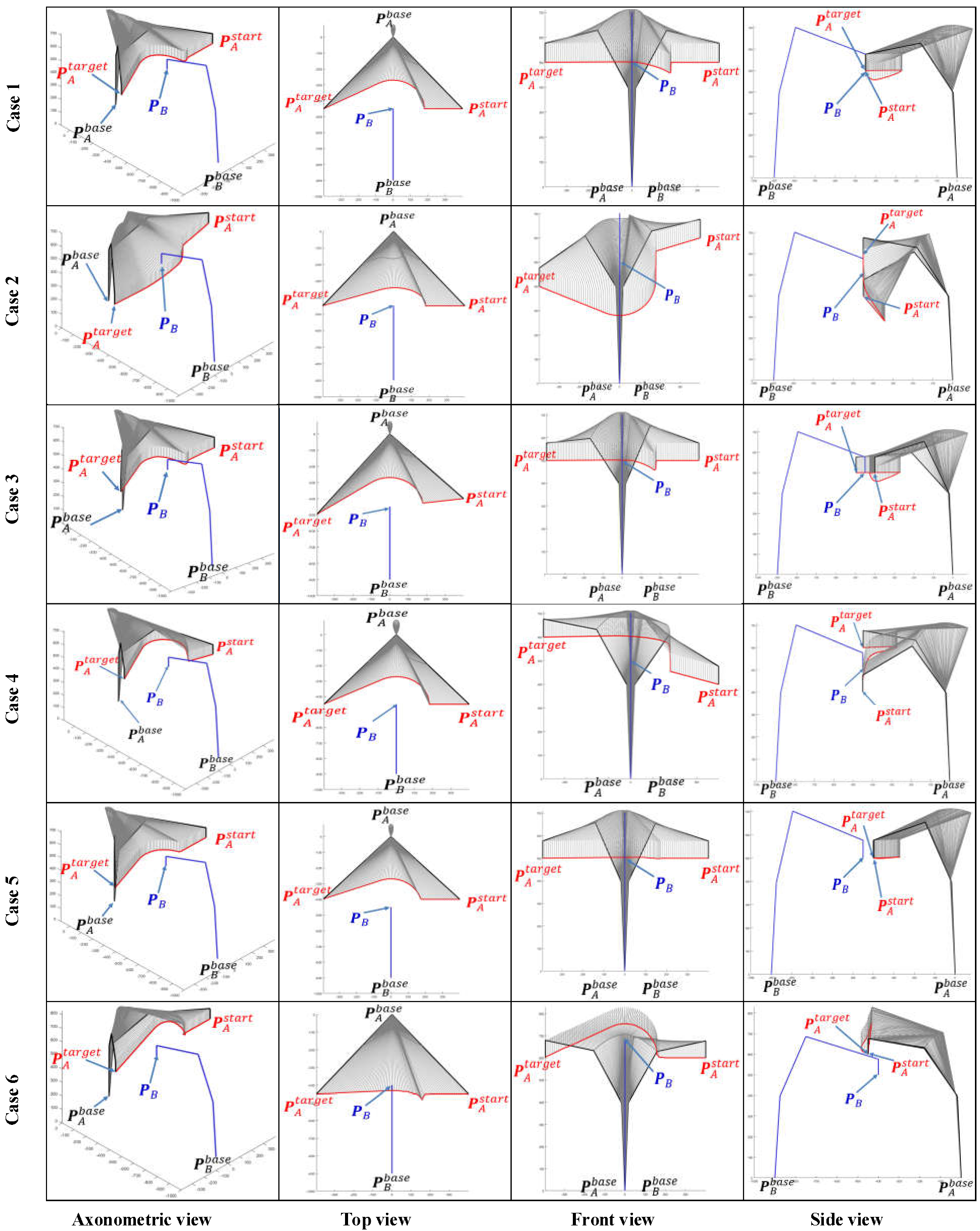A Sampling-Based Unfixed Orientation Search Method for Dual Manipulator Cooperative Manufacturing
Abstract
:1. Introduction
1.1. Subsection
1.2. Relative Work
2. Previous Work and Paper Organization
3. Mathematic Model
4. Minimum Distance Prediction
5. Sampling-Based Unfixed Orientation Search Method
6. Simulation and Analysis
6.1. Simulation of Single Manipulator Avoidance
6.2. Simulation of Dual Manipulator Avoidance
7. Conclusions
Author Contributions
Funding
Data Availability Statement
Conflicts of Interest
References
- Caccavale, F.; Uchiyama, M. Cooperative Manipulation. In Springer Handbook of Robotics; Siciliano, B., Khatib, O., Eds.; Springer: Cham, Switzerland. [CrossRef]
- Jonas, S.; Verena, K.; Christin, H.; Klaus, B. Human Centered Assistance Applications for the working environment of the future. Occup. Ergon. 2015, 12, 83–95. [Google Scholar]
- Iina, A.; Timo, S.; Ilari, M. Refining levels of collaboration to support the design and evaluation of human-robot interaction in the manufacturing industry. In Proceedings of the 51st CIRP Conference on Manufacturing Systems, Stockholm, Sweden, 16–18 May 2018; Volume 72, pp. 93–98. [Google Scholar]
- Choi, M.; Lim, S.; Lee, J. Cooperative Path Planning for Redundant Dual-Arm Robot Using Low-Dimensional Sample-Based Algorithm. Mechatron. Syst. 2010, 43, 701–708. [Google Scholar] [CrossRef]
- Nash, A.; Koenig, S.; Tovey, C. Lazy theta∗: Any-angle path planning and path length analysis in 3D. In Proceedings of the Third Annual Symposium on Combinatorial Search, Atlanta, GA, USA, 8–10 July 2010; Volume 2, pp. 153–154. [Google Scholar]
- Jia, Q.; Chen, G.; Sun, H.; Zheng, H. Path planning for space manipulator to avoid obstacle based on A* algorithm. Chin. J. Mech. Eng. 2010, 46, 109–115. [Google Scholar] [CrossRef]
- Yu, N.; Wang, Z. Collision avoidance planning of manipulator based on C-space layered search arithmetic. In Proceedings of the International Conference on Electronic and Mechanical Engineering and Information Technology (EMEIT), Harbin, China, 12–14 August 2011; pp. 3258–3262. [Google Scholar]
- Li, L.; Shi, Z.; Guan, Y.; Zhao, C.; Zhang, J.; Wei, H. Formal verification of a collision-free algorithm of dual-arm robot in HOL4. In Proceedings of the IEEE International Conference on Robotics & Automation (ICRA), Hong Kong, China, 31 May–7 June 2014; pp. 1380–1385. [Google Scholar]
- Harada, K.; Foissotte, T.; Tsuji, T.; Nagata, K.; Yamanobe, N.; Nakamura, A.; Kawai, Y. Pick and place planning for dual-arm manipulators. In Proceedings of the IEEE International Conference on Robotics and Automation, Saint Paul, MN, USA, 14–18 May 2012; pp. 2281–2286. [Google Scholar]
- Lee, S.; Moradi, H.; Yi, C. A real-time dual-arm collision avoidance algorithm for assembly. In Proceedings of the IEEE International Symposium on Assembly and Task Planning, Marina del Rey, CA, USA, 7–9 August 1997; pp. 7–12. [Google Scholar]
- Larsen, L.; Pham, V.L.; Kim, J.; Kupke, M. Collision-free path planning of industrial cooperating robots for aircraft fuselage production. In Proceedings of the IEEE International Conference on Robotics and Automation, Seattle, WA, USA, 25 May 2015; p. 2042. [Google Scholar]
- Cohen, B.; Chitta, S.; Likhachev, M. Single- and dual-arm motion planning with heuristic search. Int. J. Robot. Res. 2014, 33, 305. [Google Scholar] [CrossRef] [Green Version]
- Chiddarwar, S.S.; Ramesh, B.N. Conflict free coordinated path planning for multiple robots using a dynamic path modification sequence. Robot. Auton. Syst. 2011, 59, 508. [Google Scholar] [CrossRef]
- Afaghani, A.Y.; Aiyama, Y. Advanced-collision-map-based online collision and deadlock avoidance between two robot manipulators with PTP commands. In Proceedings of the IEEE International Conference on Automation Science and Engineering (CASE), New Taipei, Taiwan, 18–22 August 2014; pp. 1244–1251. [Google Scholar]
- Rodríguez, C.; Montano, A.; Suarez, R. Planning manipulation movements of a dual-arm system considering obstacle removing. Robot. Auton. Syst. 2014, 62, 1816. [Google Scholar] [CrossRef] [Green Version]
- Korayem, M.H.; Nekoo, S.R. The SDRE control of mobile base cooperative manipulators: Collision free path planning and moving obstacle avoidance. Robot. Auton. Syst. 2016, 86, 86–105. [Google Scholar] [CrossRef]
- Yang, L.; Qi, J.; Song, D.; Xiao, J.; Han, J.; Xia, Y. Survey of Robot 3D Path Planning Algorithms. J. Control. Sci. Eng. 2016, 1, 22. [Google Scholar] [CrossRef] [Green Version]
- Zhu, X.; Yan, B.; Yue, Y. Path Planning and Collision Avoidance in Unknown Environments for USVs Based on an Improved D* Lite. Appl. Sci. 2021, 11, 7863. [Google Scholar] [CrossRef]
- Faria, M.; Marín, R.; Popović, M.; Maza, I.; Viguria, A. Efficient Lazy Theta* Path Planning over a Sparse Grid to Explore Large 3D Volumes with a Multirotor UAV. Sensors 2019, 19, 174. [Google Scholar] [CrossRef] [PubMed] [Green Version]
- Luo, M.; Hou, X.; Yang, J. Surface Optimal Path Planning Using an Extended Dijkstra Algorithm. IEEE Access 2020, 8, 147827. [Google Scholar] [CrossRef]
- Schömer, P.; Hüneberg, M.T.; Zöllner, J.M. Optimization of Sampling-Based Motion Planning in Dynamic Environments Using Neural Networks. In Proceedings of the IEEE Intelligent Vehicles Symposium (IV), Las Vegas, NV, USA, 19 October–13 November 2020; pp. 2110–2117. [Google Scholar]
- Wang, J.; Li, C.X.-T.; Chi, W.; Meng, M.Q.-H. Tropistic RRT*: An Efficient Planning Algorithm via Adaptive Restricted Sampling Space. In Proceedings of the IEEE International Conference on Information and Automation (ICIA), Wuyishan, China, 11–13 August 2018; 2018; pp. 1639–1646. [Google Scholar]
- Yang, S.M.; Lin, Y.A. Development of an Improved Rapidly Exploring Random Trees Algorithm for Static Obstacle Avoidance in Autonomous Vehicles. Sensors 2021, 21, 2244. [Google Scholar] [CrossRef] [PubMed]
- Heo, Y.J.; Kim, D.; Lee, W.; Kim, H.; Park, J.; Chung, W.K. Collision Detection for Industrial Collaborative Robots: A Deep Learning Approach. IEEE Robot. Autom. Lett. 2019, 4, 740–746. [Google Scholar] [CrossRef]
- Casalino, A.; Brameri, A.; Zanchettin, A.M.; Rocco, P. Adaptive swept volumes generation for human-robot coexistence using Gaussian Processes. In Proceedings of the IEEE/RSJ International Conference on Intelligent Robots and Systems (IROS), Macau, China, 3–8 November 2019; p. 3823. [Google Scholar]
- Lumelsky, V.J. On fast computation of distance between line segments. Inf. Processing Lett. 1985, 21, 55–61. [Google Scholar] [CrossRef]


















| Case 1 | Case 2 | Case 3 | Case 4 | Case 5 | Case 6 | |
|---|---|---|---|---|---|---|
| SbUOSM | 4899.4 | 7183.7 | 7619.6 | 8185.9 | 7586.8 | 10,844 |
| A* in C-space | 13,161 | 20,914 | 19,047 | 21,187 | 16,150 | 19,153 |
| SbOSMS | 5814.5 | 8461.6 | 9015.4 | 8794.1 | 8629.2 | 11,878 |
| Case 1 | Case 2 | Case 3 | Case 4 | Case 5 | Case 6 | |
|---|---|---|---|---|---|---|
| SbUOSM | 6876.7/95 | 6825.9/93 | 7703.3/95 | 7045.5/96 | 6405.9/88 | 8892.3/121 |
| A* in C-space | 45,992.6/145 | 38,291.4/131 | 48,498.9/151 | 38,153.8/131 | 42,050.7/138 | 46,764.1/142 |
| SbOSMS | 13,477/95 | 13,313.9/93 | 13,148.3/97 | 13,340.8/97 | 12,391/89 | 17,043.8/112 |
| Case 1 | Case 2 | Case 3 | Case 4 | Case 5 | |
|---|---|---|---|---|---|
| SbUOSM | 3944.9 | 5457.9 | 5647.5 | 4857.7 | 5846.8 |
| A* in C-space | 8341.2 | 9276.3 | 9373.5 | 8887.8 | 9006.1 |
| SbOSMS | 4280.3 | 6162.2 | 8126.8 | 5964.7 | 6765.3 |
| Case 1 | Case 2 | Case 3 | Case 4 | Case 5 | |
|---|---|---|---|---|---|
| SbUOSM | 16,650.6/90 | 16,029.7/88 | 16,344.1/88 | 18,334.9/100 | 18,641.7/103 |
| A* in C-space | 68,246.3/107 | 67,822.4/108 | 65,255.6/106 | 69,112.5/107 | 67,594.8/104 |
| SbOSMS | 50,392.1/85 | 58,154.9/91 | 66,888.6/92 | 54,660.6/91 | 57,083.3/92 |
Publisher’s Note: MDPI stays neutral with regard to jurisdictional claims in published maps and institutional affiliations. |
© 2022 by the authors. Licensee MDPI, Basel, Switzerland. This article is an open access article distributed under the terms and conditions of the Creative Commons Attribution (CC BY) license (https://creativecommons.org/licenses/by/4.0/).
Share and Cite
Su, C.; Xu, J. A Sampling-Based Unfixed Orientation Search Method for Dual Manipulator Cooperative Manufacturing. Sensors 2022, 22, 2502. https://doi.org/10.3390/s22072502
Su C, Xu J. A Sampling-Based Unfixed Orientation Search Method for Dual Manipulator Cooperative Manufacturing. Sensors. 2022; 22(7):2502. https://doi.org/10.3390/s22072502
Chicago/Turabian StyleSu, Chang, and Jianfeng Xu. 2022. "A Sampling-Based Unfixed Orientation Search Method for Dual Manipulator Cooperative Manufacturing" Sensors 22, no. 7: 2502. https://doi.org/10.3390/s22072502






